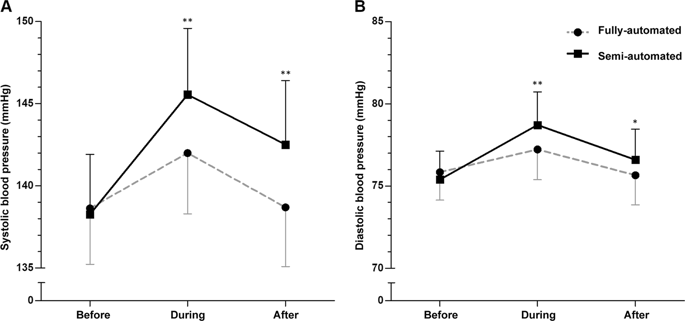当前位置:
X-MOL 学术
›
J. Hum. Hypertens.
›
论文详情
Our official English website, www.x-mol.net, welcomes your
feedback! (Note: you will need to create a separate account there.)
Effect of self-initiated and fully-automated self-measurement on blood pressure.
Journal of Human Hypertension ( IF 2.7 ) Pub Date : 2019-09-23 , DOI: 10.1038/s41371-019-0256-1 Rosanne T Berkhof 1 , Katia Gazzola 1, 2 , Bert-Jan H van den Born 1
Journal of Human Hypertension ( IF 2.7 ) Pub Date : 2019-09-23 , DOI: 10.1038/s41371-019-0256-1 Rosanne T Berkhof 1 , Katia Gazzola 1, 2 , Bert-Jan H van den Born 1
Affiliation

|
Self-measurement of blood pressure (BP) is regularly used to diagnose hypertension and to monitor BP at home. We recently showed that self-measurement of BP may elicit a pressor or 'auto-cuff' response. In this study we examined whether the pressor response is different between self-initiated and fully-automated BP measurement. We performed two randomized crossover studies in outpatients visiting a hypertension clinic. The first cohort of 52 participants performed six unattended self-initiated and six fully-automated BP measurements, while continuously monitoring BP and central haemodynamics using finger photoplethysmography. The second cohort consisted of 120 patients who performed three self-initiated and three fully-automated BP measurements. In the first cohort (mean age 61.2 ± 10.4 years, mean office BP 142.0 ± 19.9/82.5 ± 12.2 mmHg, 36.7% female) average systolic and diastolic BP increased by 7.3 ± 8.5/3.3 ± 4.0 mmHg in the group with self-initiated BP measurements, while BP increased by 3.3 ± 6.3/1.4 ± 3.0 mmHg during fully-automated measurements (p = 0.002/p = 0.002 for difference between groups). The higher BP increase during self-initiated BP measurements resulted from an increase in heart rate and cardiac output. In the second cohort (mean age 58.0 ± 14.1 years, mean office BP 153.6 ± 23.8/86.3 ± 14.0 mmHg, 44.1% female) self-initiated BP measurement resulted in a 2.1 ± 6.8/0.9 ± 4.0 mmHg higher systolic and diastolic BP compared with fully-automated self-measurement (p = 0.001/0.018). In conclusion, our findings suggest that self-initiated BP measurement using a fully-automated method results in a more reliable BP compared with a self-initiated semi-automated method by attenuating the auto-cuff response. These findings may have implications for the self-measurement of BP.
中文翻译:

自启动和全自动自测对血压的影响。
自我测量血压 (BP) 经常用于诊断高血压和在家监测血压。我们最近表明,BP 的自我测量可能会引发升压或“自动袖带”反应。在这项研究中,我们检查了自启动和全自动血压测量之间的升压反应是否不同。我们在高血压门诊就诊的门诊患者中进行了两项随机交叉研究。第一批 52 名参与者进行了六次无人值守的自启动和六次全自动血压测量,同时使用手指光电容积描记法持续监测血压和中心血流动力学。第二组由 120 名患者组成,他们进行了三项自启动和三项全自动血压测量。在第一组中(平均年龄 61.2 ± 10.4 岁,平均诊室血压 142.0 ± 19.9/82.5 ± 12.2 mmHg,36.7% 女性)平均收缩压和舒张压在自行启动 BP 测量组中增加了 7.3 ± 8.5/3.3 ± 4.0 mmHg,而在全自动测量期间 BP 增加了 3.3 ± 6.3/1.4 ± 3.0 mmHg(p = 0.002 /p = 0.002 组间差异)。自我启动的血压测量过程中较高的血压升高是由于心率和心输出量的增加。在第二个队列中(平均年龄 58.0 ± 14.1 岁,平均诊室 BP 153.6 ± 23.8/86.3 ± 14.0 mmHg,44.1% 女性)自行启动的血压测量导致收缩压和舒张压高 2.1 ± 6.8/0.9 ± 4.0 mmHg全自动自测 (p = 0.001/0.018)。综上所述,我们的研究结果表明,与通过减弱自动袖带响应的自启动半自动方法相比,使用全自动方法的自启动血压测量结果更可靠。这些发现可能对血压的自我测量有影响。
更新日期:2019-09-23
中文翻译:

自启动和全自动自测对血压的影响。
自我测量血压 (BP) 经常用于诊断高血压和在家监测血压。我们最近表明,BP 的自我测量可能会引发升压或“自动袖带”反应。在这项研究中,我们检查了自启动和全自动血压测量之间的升压反应是否不同。我们在高血压门诊就诊的门诊患者中进行了两项随机交叉研究。第一批 52 名参与者进行了六次无人值守的自启动和六次全自动血压测量,同时使用手指光电容积描记法持续监测血压和中心血流动力学。第二组由 120 名患者组成,他们进行了三项自启动和三项全自动血压测量。在第一组中(平均年龄 61.2 ± 10.4 岁,平均诊室血压 142.0 ± 19.9/82.5 ± 12.2 mmHg,36.7% 女性)平均收缩压和舒张压在自行启动 BP 测量组中增加了 7.3 ± 8.5/3.3 ± 4.0 mmHg,而在全自动测量期间 BP 增加了 3.3 ± 6.3/1.4 ± 3.0 mmHg(p = 0.002 /p = 0.002 组间差异)。自我启动的血压测量过程中较高的血压升高是由于心率和心输出量的增加。在第二个队列中(平均年龄 58.0 ± 14.1 岁,平均诊室 BP 153.6 ± 23.8/86.3 ± 14.0 mmHg,44.1% 女性)自行启动的血压测量导致收缩压和舒张压高 2.1 ± 6.8/0.9 ± 4.0 mmHg全自动自测 (p = 0.001/0.018)。综上所述,我们的研究结果表明,与通过减弱自动袖带响应的自启动半自动方法相比,使用全自动方法的自启动血压测量结果更可靠。这些发现可能对血压的自我测量有影响。

































 京公网安备 11010802027423号
京公网安备 11010802027423号